Chinook Choppers Project: Leadership, Motivation, Stakeholder Analysis
VerifiedAdded on 2020/04/21
|15
|3716
|70
Project
AI Summary
This project analyzes the Chinook Choppers project, focusing on leadership, motivation, and stakeholder management within a business context. It begins by identifying key internal and external stakeholders, such as employees, owners, customers, and suppliers, and outlines their expectations and the challenges of effective collaboration. The project then delves into project management and leadership theories, critically analyzing transactional and transformational leadership, recommending a preferred approach, and identifying imperative leadership traits. Furthermore, it examines motivational strategies in project management, exploring factors that demotivate employees and techniques to improve motivation, including effective communication, and analyzing major theories of motivation. The project also provides techniques for self-motivation and concludes with a bibliography of sources used.
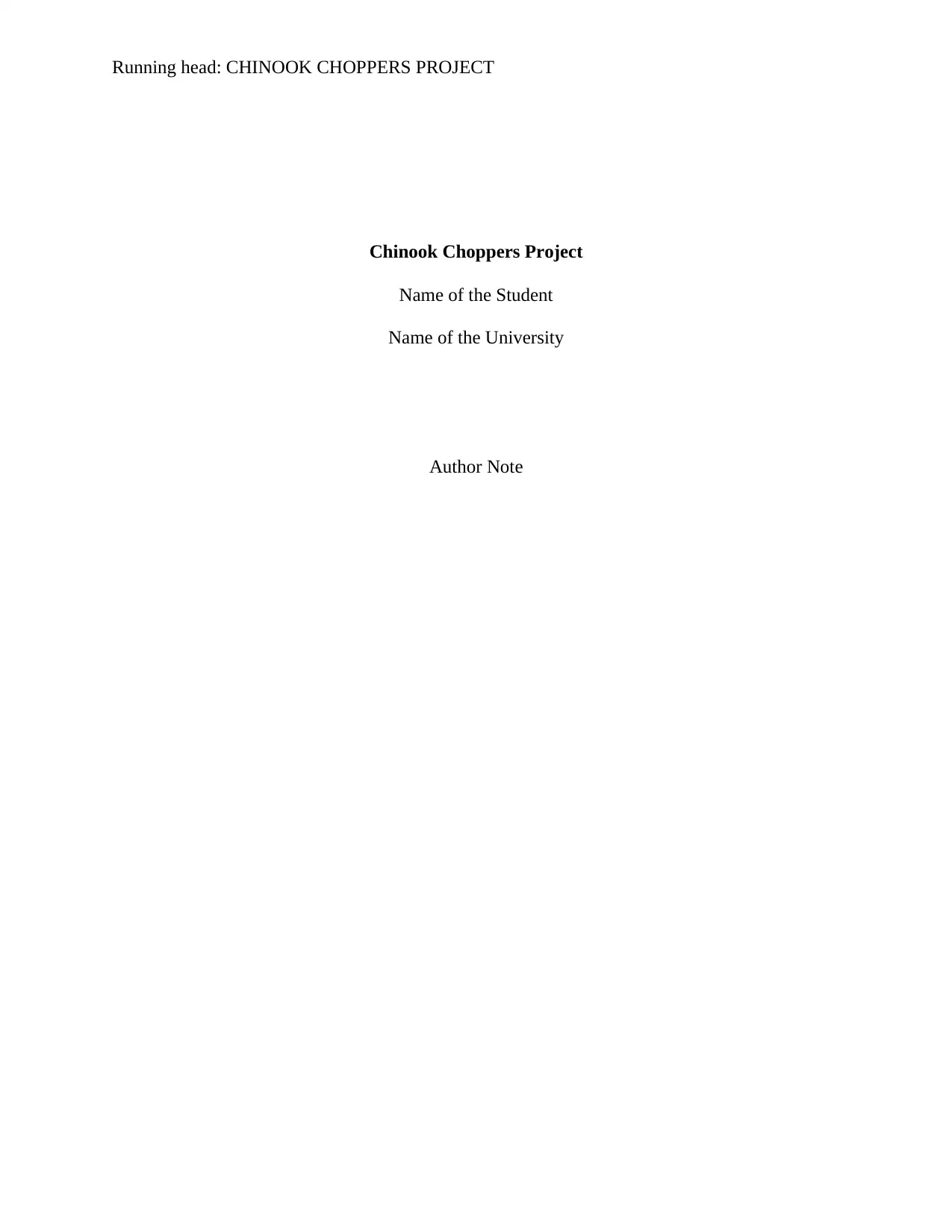
Running head: CHINOOK CHOPPERS PROJECT
Chinook Choppers Project
Name of the Student
Name of the University
Author Note
Chinook Choppers Project
Name of the Student
Name of the University
Author Note
Paraphrase This Document
Need a fresh take? Get an instant paraphrase of this document with our AI Paraphraser
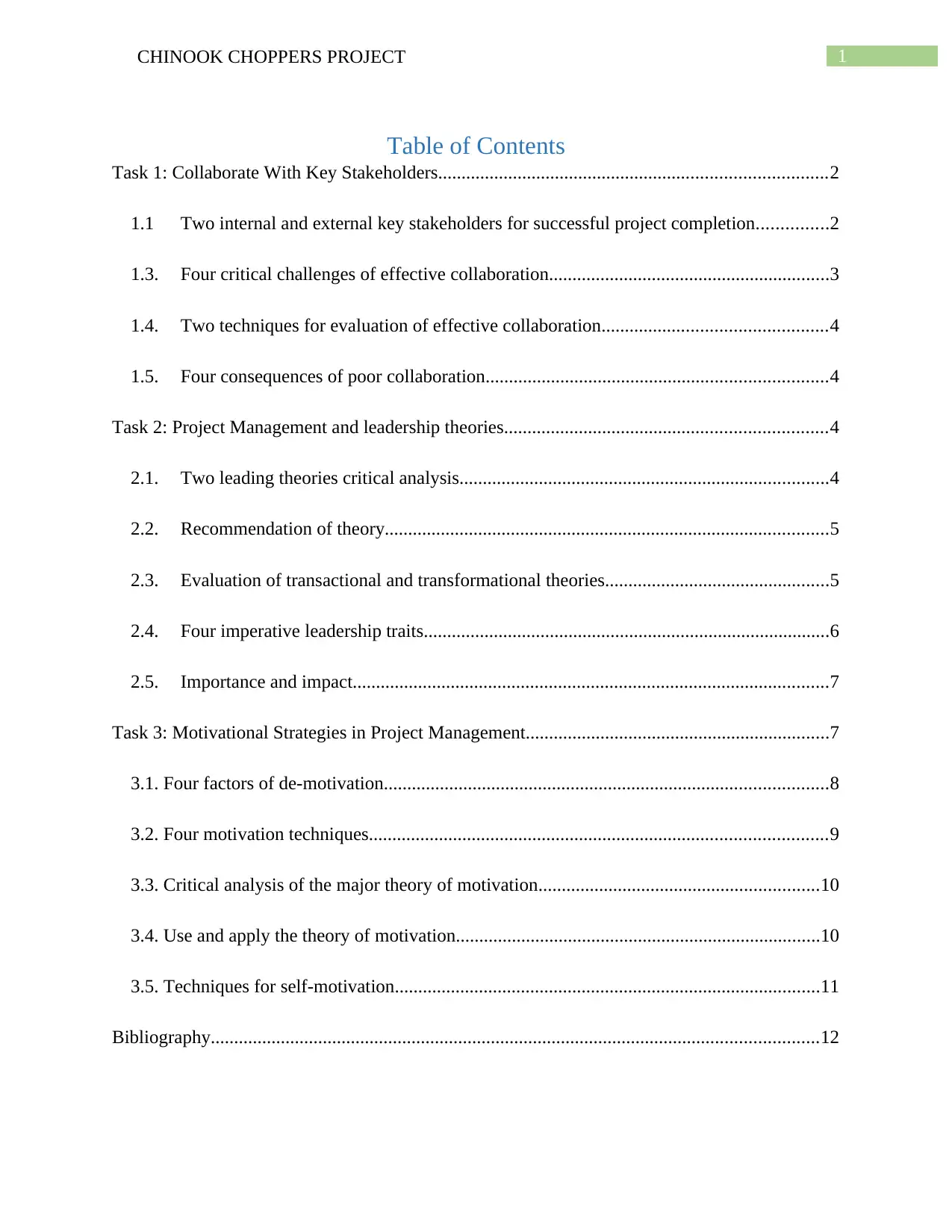
1CHINOOK CHOPPERS PROJECT
Table of Contents
Task 1: Collaborate With Key Stakeholders...................................................................................2
1.1 Two internal and external key stakeholders for successful project completion...............2
1.3. Four critical challenges of effective collaboration............................................................3
1.4. Two techniques for evaluation of effective collaboration................................................4
1.5. Four consequences of poor collaboration.........................................................................4
Task 2: Project Management and leadership theories.....................................................................4
2.1. Two leading theories critical analysis...............................................................................4
2.2. Recommendation of theory...............................................................................................5
2.3. Evaluation of transactional and transformational theories................................................5
2.4. Four imperative leadership traits.......................................................................................6
2.5. Importance and impact......................................................................................................7
Task 3: Motivational Strategies in Project Management.................................................................7
3.1. Four factors of de-motivation...............................................................................................8
3.2. Four motivation techniques..................................................................................................9
3.3. Critical analysis of the major theory of motivation............................................................10
3.4. Use and apply the theory of motivation..............................................................................10
3.5. Techniques for self-motivation...........................................................................................11
Bibliography..................................................................................................................................12
Table of Contents
Task 1: Collaborate With Key Stakeholders...................................................................................2
1.1 Two internal and external key stakeholders for successful project completion...............2
1.3. Four critical challenges of effective collaboration............................................................3
1.4. Two techniques for evaluation of effective collaboration................................................4
1.5. Four consequences of poor collaboration.........................................................................4
Task 2: Project Management and leadership theories.....................................................................4
2.1. Two leading theories critical analysis...............................................................................4
2.2. Recommendation of theory...............................................................................................5
2.3. Evaluation of transactional and transformational theories................................................5
2.4. Four imperative leadership traits.......................................................................................6
2.5. Importance and impact......................................................................................................7
Task 3: Motivational Strategies in Project Management.................................................................7
3.1. Four factors of de-motivation...............................................................................................8
3.2. Four motivation techniques..................................................................................................9
3.3. Critical analysis of the major theory of motivation............................................................10
3.4. Use and apply the theory of motivation..............................................................................10
3.5. Techniques for self-motivation...........................................................................................11
Bibliography..................................................................................................................................12
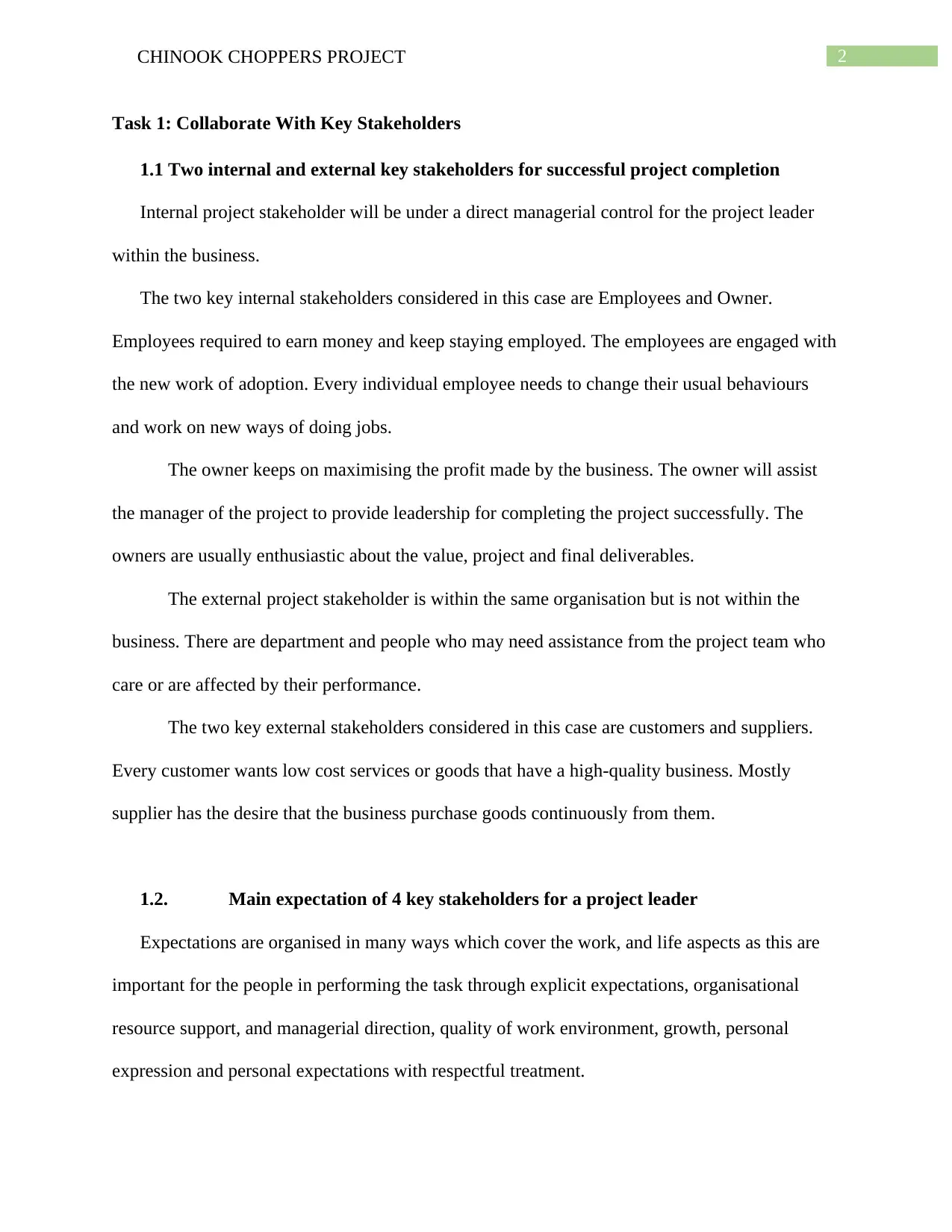
2CHINOOK CHOPPERS PROJECT
Task 1: Collaborate With Key Stakeholders
1.1 Two internal and external key stakeholders for successful project completion
Internal project stakeholder will be under a direct managerial control for the project leader
within the business.
The two key internal stakeholders considered in this case are Employees and Owner.
Employees required to earn money and keep staying employed. The employees are engaged with
the new work of adoption. Every individual employee needs to change their usual behaviours
and work on new ways of doing jobs.
The owner keeps on maximising the profit made by the business. The owner will assist
the manager of the project to provide leadership for completing the project successfully. The
owners are usually enthusiastic about the value, project and final deliverables.
The external project stakeholder is within the same organisation but is not within the
business. There are department and people who may need assistance from the project team who
care or are affected by their performance.
The two key external stakeholders considered in this case are customers and suppliers.
Every customer wants low cost services or goods that have a high-quality business. Mostly
supplier has the desire that the business purchase goods continuously from them.
1.2. Main expectation of 4 key stakeholders for a project leader
Expectations are organised in many ways which cover the work, and life aspects as this are
important for the people in performing the task through explicit expectations, organisational
resource support, and managerial direction, quality of work environment, growth, personal
expression and personal expectations with respectful treatment.
Task 1: Collaborate With Key Stakeholders
1.1 Two internal and external key stakeholders for successful project completion
Internal project stakeholder will be under a direct managerial control for the project leader
within the business.
The two key internal stakeholders considered in this case are Employees and Owner.
Employees required to earn money and keep staying employed. The employees are engaged with
the new work of adoption. Every individual employee needs to change their usual behaviours
and work on new ways of doing jobs.
The owner keeps on maximising the profit made by the business. The owner will assist
the manager of the project to provide leadership for completing the project successfully. The
owners are usually enthusiastic about the value, project and final deliverables.
The external project stakeholder is within the same organisation but is not within the
business. There are department and people who may need assistance from the project team who
care or are affected by their performance.
The two key external stakeholders considered in this case are customers and suppliers.
Every customer wants low cost services or goods that have a high-quality business. Mostly
supplier has the desire that the business purchase goods continuously from them.
1.2. Main expectation of 4 key stakeholders for a project leader
Expectations are organised in many ways which cover the work, and life aspects as this are
important for the people in performing the task through explicit expectations, organisational
resource support, and managerial direction, quality of work environment, growth, personal
expression and personal expectations with respectful treatment.
⊘ This is a preview!⊘
Do you want full access?
Subscribe today to unlock all pages.

Trusted by 1+ million students worldwide
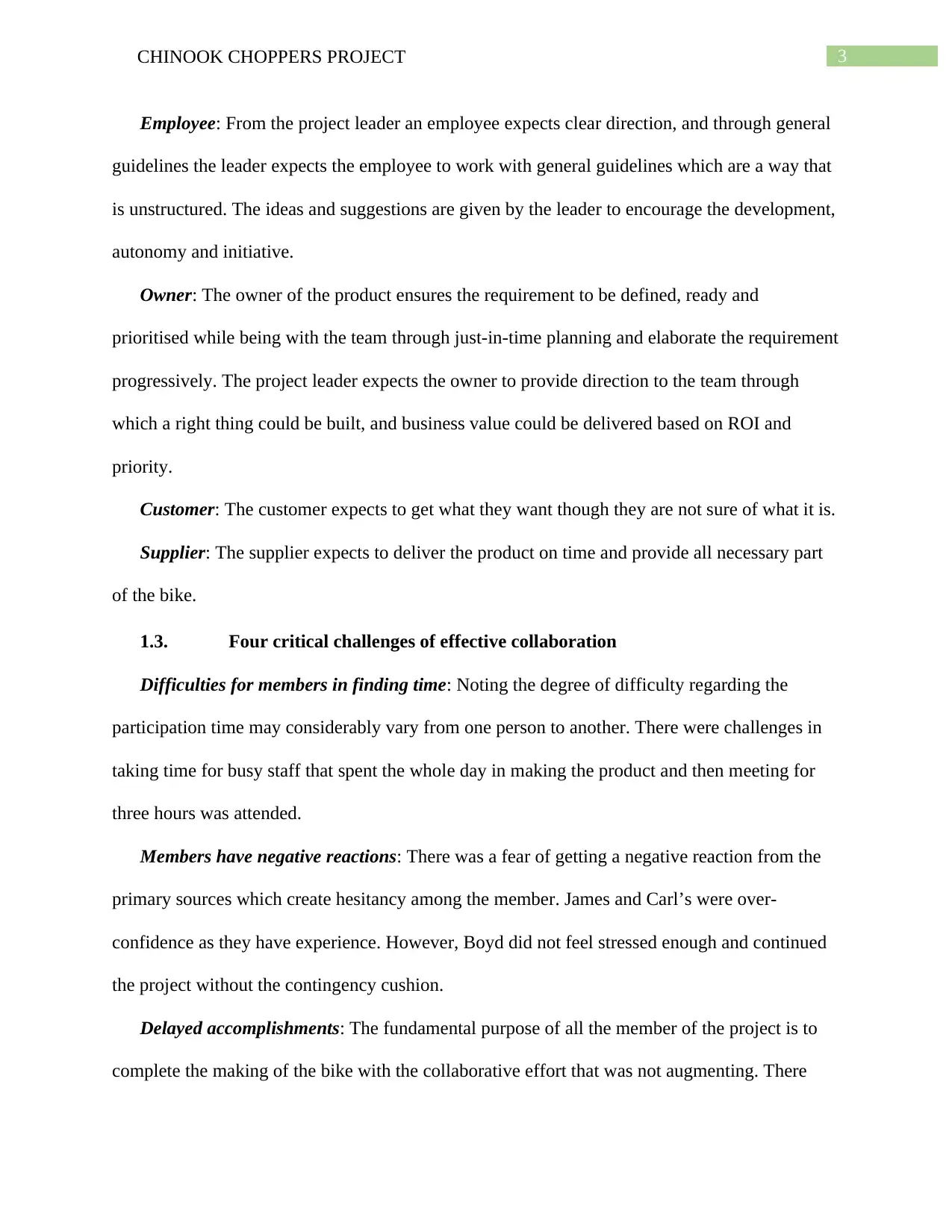
3CHINOOK CHOPPERS PROJECT
Employee: From the project leader an employee expects clear direction, and through general
guidelines the leader expects the employee to work with general guidelines which are a way that
is unstructured. The ideas and suggestions are given by the leader to encourage the development,
autonomy and initiative.
Owner: The owner of the product ensures the requirement to be defined, ready and
prioritised while being with the team through just-in-time planning and elaborate the requirement
progressively. The project leader expects the owner to provide direction to the team through
which a right thing could be built, and business value could be delivered based on ROI and
priority.
Customer: The customer expects to get what they want though they are not sure of what it is.
Supplier: The supplier expects to deliver the product on time and provide all necessary part
of the bike.
1.3. Four critical challenges of effective collaboration
Difficulties for members in finding time: Noting the degree of difficulty regarding the
participation time may considerably vary from one person to another. There were challenges in
taking time for busy staff that spent the whole day in making the product and then meeting for
three hours was attended.
Members have negative reactions: There was a fear of getting a negative reaction from the
primary sources which create hesitancy among the member. James and Carl’s were over-
confidence as they have experience. However, Boyd did not feel stressed enough and continued
the project without the contingency cushion.
Delayed accomplishments: The fundamental purpose of all the member of the project is to
complete the making of the bike with the collaborative effort that was not augmenting. There
Employee: From the project leader an employee expects clear direction, and through general
guidelines the leader expects the employee to work with general guidelines which are a way that
is unstructured. The ideas and suggestions are given by the leader to encourage the development,
autonomy and initiative.
Owner: The owner of the product ensures the requirement to be defined, ready and
prioritised while being with the team through just-in-time planning and elaborate the requirement
progressively. The project leader expects the owner to provide direction to the team through
which a right thing could be built, and business value could be delivered based on ROI and
priority.
Customer: The customer expects to get what they want though they are not sure of what it is.
Supplier: The supplier expects to deliver the product on time and provide all necessary part
of the bike.
1.3. Four critical challenges of effective collaboration
Difficulties for members in finding time: Noting the degree of difficulty regarding the
participation time may considerably vary from one person to another. There were challenges in
taking time for busy staff that spent the whole day in making the product and then meeting for
three hours was attended.
Members have negative reactions: There was a fear of getting a negative reaction from the
primary sources which create hesitancy among the member. James and Carl’s were over-
confidence as they have experience. However, Boyd did not feel stressed enough and continued
the project without the contingency cushion.
Delayed accomplishments: The fundamental purpose of all the member of the project is to
complete the making of the bike with the collaborative effort that was not augmenting. There
Paraphrase This Document
Need a fresh take? Get an instant paraphrase of this document with our AI Paraphraser
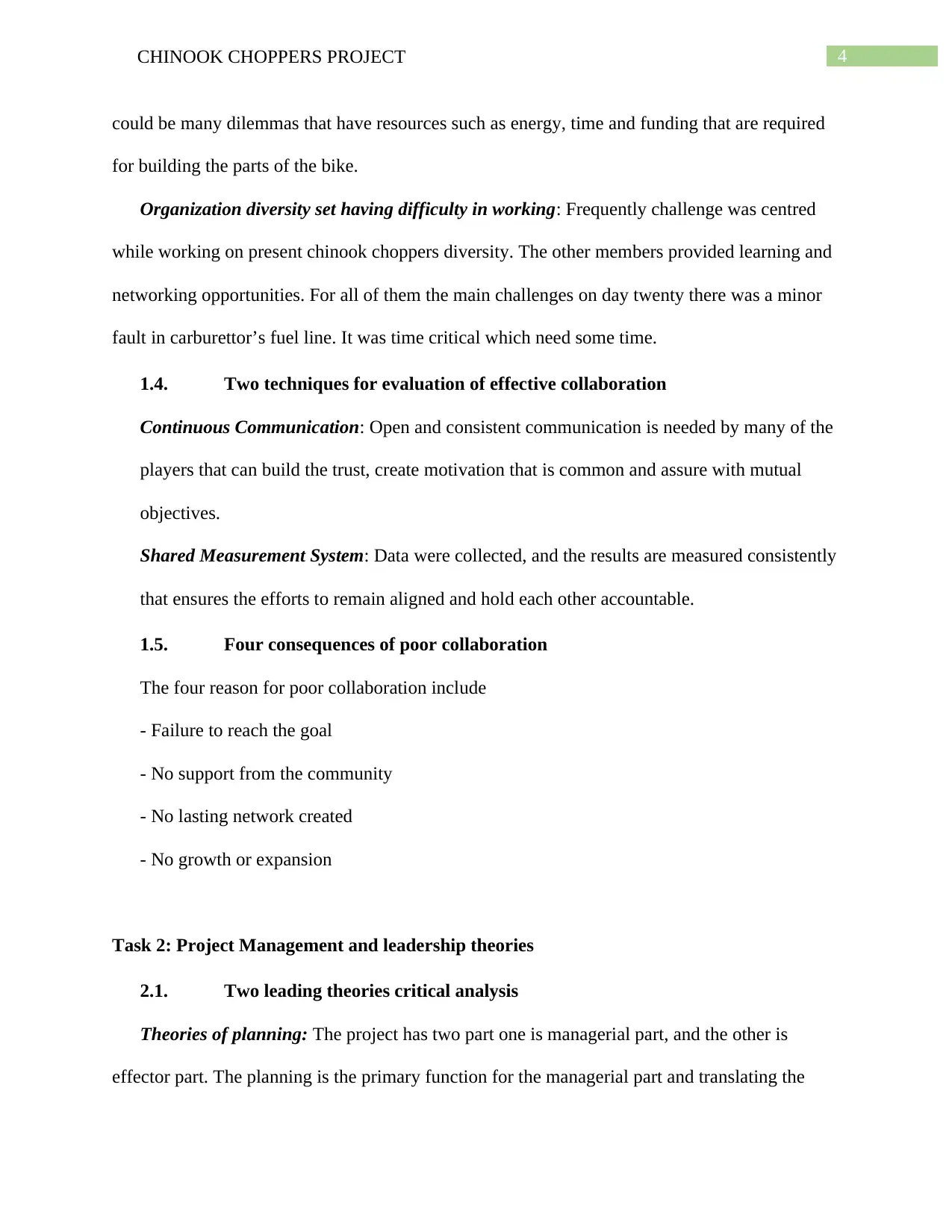
4CHINOOK CHOPPERS PROJECT
could be many dilemmas that have resources such as energy, time and funding that are required
for building the parts of the bike.
Organization diversity set having difficulty in working: Frequently challenge was centred
while working on present chinook choppers diversity. The other members provided learning and
networking opportunities. For all of them the main challenges on day twenty there was a minor
fault in carburettor’s fuel line. It was time critical which need some time.
1.4. Two techniques for evaluation of effective collaboration
Continuous Communication: Open and consistent communication is needed by many of the
players that can build the trust, create motivation that is common and assure with mutual
objectives.
Shared Measurement System: Data were collected, and the results are measured consistently
that ensures the efforts to remain aligned and hold each other accountable.
1.5. Four consequences of poor collaboration
The four reason for poor collaboration include
- Failure to reach the goal
- No support from the community
- No lasting network created
- No growth or expansion
Task 2: Project Management and leadership theories
2.1. Two leading theories critical analysis
Theories of planning: The project has two part one is managerial part, and the other is
effector part. The planning is the primary function for the managerial part and translating the
could be many dilemmas that have resources such as energy, time and funding that are required
for building the parts of the bike.
Organization diversity set having difficulty in working: Frequently challenge was centred
while working on present chinook choppers diversity. The other members provided learning and
networking opportunities. For all of them the main challenges on day twenty there was a minor
fault in carburettor’s fuel line. It was time critical which need some time.
1.4. Two techniques for evaluation of effective collaboration
Continuous Communication: Open and consistent communication is needed by many of the
players that can build the trust, create motivation that is common and assure with mutual
objectives.
Shared Measurement System: Data were collected, and the results are measured consistently
that ensures the efforts to remain aligned and hold each other accountable.
1.5. Four consequences of poor collaboration
The four reason for poor collaboration include
- Failure to reach the goal
- No support from the community
- No lasting network created
- No growth or expansion
Task 2: Project Management and leadership theories
2.1. Two leading theories critical analysis
Theories of planning: The project has two part one is managerial part, and the other is
effector part. The planning is the primary function for the managerial part and translating the
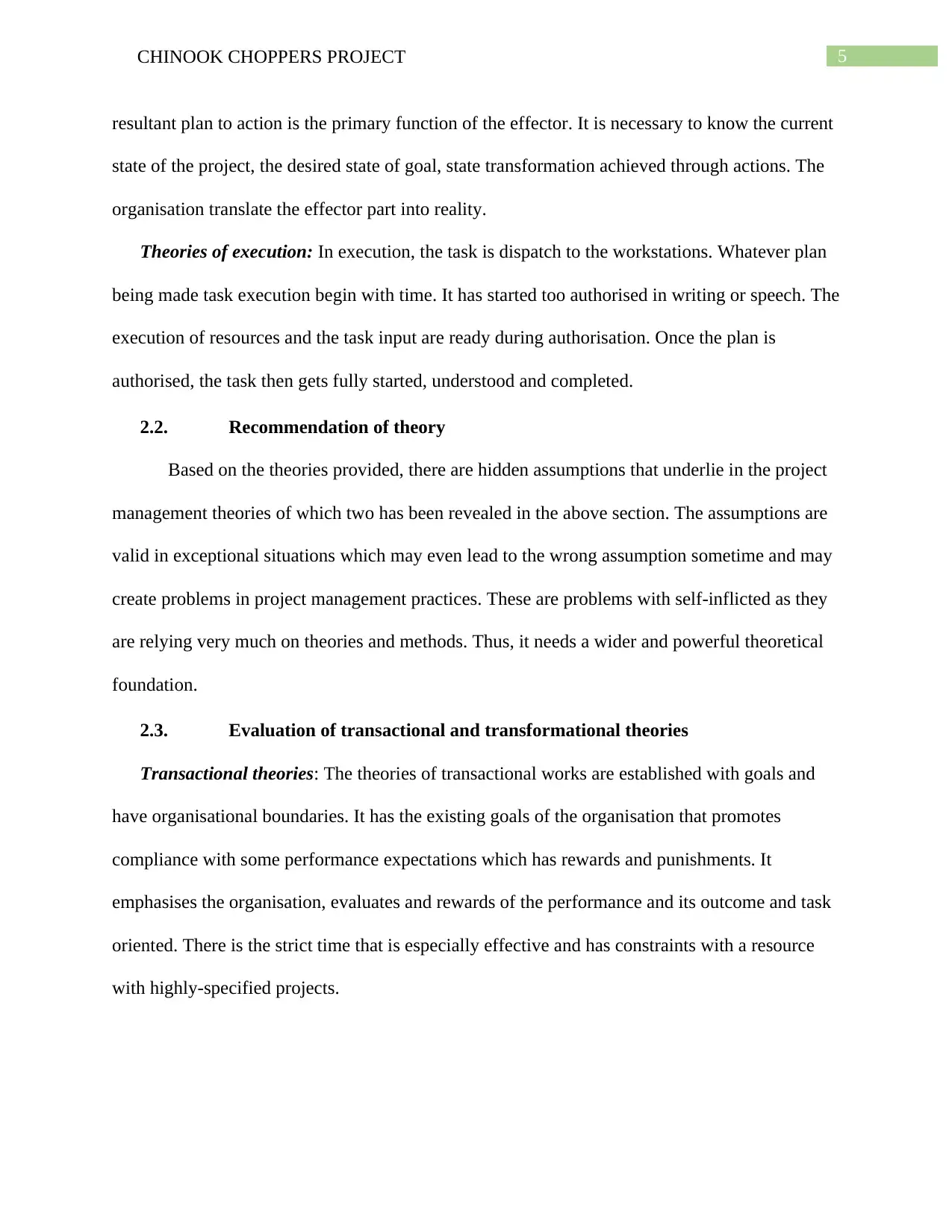
5CHINOOK CHOPPERS PROJECT
resultant plan to action is the primary function of the effector. It is necessary to know the current
state of the project, the desired state of goal, state transformation achieved through actions. The
organisation translate the effector part into reality.
Theories of execution: In execution, the task is dispatch to the workstations. Whatever plan
being made task execution begin with time. It has started too authorised in writing or speech. The
execution of resources and the task input are ready during authorisation. Once the plan is
authorised, the task then gets fully started, understood and completed.
2.2. Recommendation of theory
Based on the theories provided, there are hidden assumptions that underlie in the project
management theories of which two has been revealed in the above section. The assumptions are
valid in exceptional situations which may even lead to the wrong assumption sometime and may
create problems in project management practices. These are problems with self-inflicted as they
are relying very much on theories and methods. Thus, it needs a wider and powerful theoretical
foundation.
2.3. Evaluation of transactional and transformational theories
Transactional theories: The theories of transactional works are established with goals and
have organisational boundaries. It has the existing goals of the organisation that promotes
compliance with some performance expectations which has rewards and punishments. It
emphasises the organisation, evaluates and rewards of the performance and its outcome and task
oriented. There is the strict time that is especially effective and has constraints with a resource
with highly-specified projects.
resultant plan to action is the primary function of the effector. It is necessary to know the current
state of the project, the desired state of goal, state transformation achieved through actions. The
organisation translate the effector part into reality.
Theories of execution: In execution, the task is dispatch to the workstations. Whatever plan
being made task execution begin with time. It has started too authorised in writing or speech. The
execution of resources and the task input are ready during authorisation. Once the plan is
authorised, the task then gets fully started, understood and completed.
2.2. Recommendation of theory
Based on the theories provided, there are hidden assumptions that underlie in the project
management theories of which two has been revealed in the above section. The assumptions are
valid in exceptional situations which may even lead to the wrong assumption sometime and may
create problems in project management practices. These are problems with self-inflicted as they
are relying very much on theories and methods. Thus, it needs a wider and powerful theoretical
foundation.
2.3. Evaluation of transactional and transformational theories
Transactional theories: The theories of transactional works are established with goals and
have organisational boundaries. It has the existing goals of the organisation that promotes
compliance with some performance expectations which has rewards and punishments. It
emphasises the organisation, evaluates and rewards of the performance and its outcome and task
oriented. There is the strict time that is especially effective and has constraints with a resource
with highly-specified projects.
⊘ This is a preview!⊘
Do you want full access?
Subscribe today to unlock all pages.

Trusted by 1+ million students worldwide
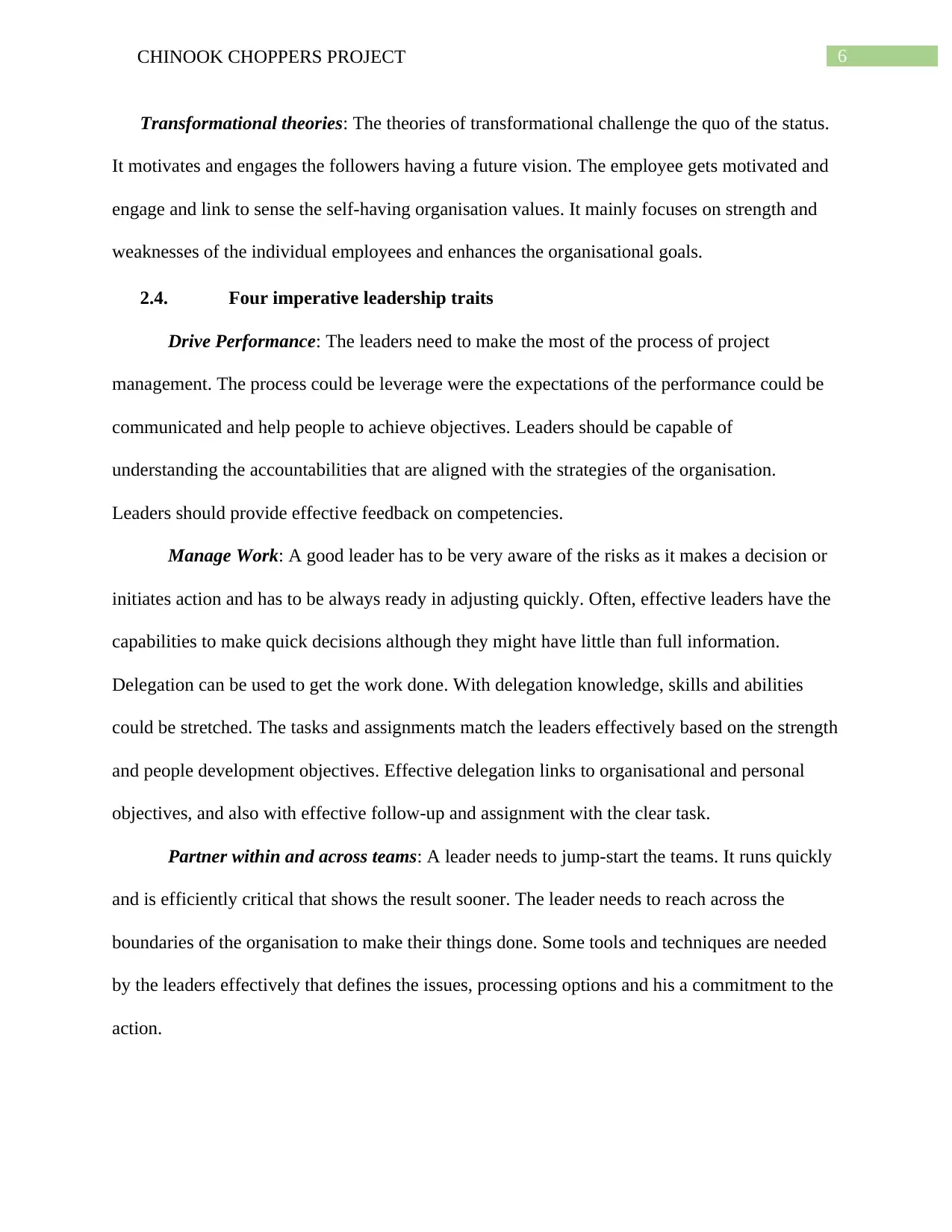
6CHINOOK CHOPPERS PROJECT
Transformational theories: The theories of transformational challenge the quo of the status.
It motivates and engages the followers having a future vision. The employee gets motivated and
engage and link to sense the self-having organisation values. It mainly focuses on strength and
weaknesses of the individual employees and enhances the organisational goals.
2.4. Four imperative leadership traits
Drive Performance: The leaders need to make the most of the process of project
management. The process could be leverage were the expectations of the performance could be
communicated and help people to achieve objectives. Leaders should be capable of
understanding the accountabilities that are aligned with the strategies of the organisation.
Leaders should provide effective feedback on competencies.
Manage Work: A good leader has to be very aware of the risks as it makes a decision or
initiates action and has to be always ready in adjusting quickly. Often, effective leaders have the
capabilities to make quick decisions although they might have little than full information.
Delegation can be used to get the work done. With delegation knowledge, skills and abilities
could be stretched. The tasks and assignments match the leaders effectively based on the strength
and people development objectives. Effective delegation links to organisational and personal
objectives, and also with effective follow-up and assignment with the clear task.
Partner within and across teams: A leader needs to jump-start the teams. It runs quickly
and is efficiently critical that shows the result sooner. The leader needs to reach across the
boundaries of the organisation to make their things done. Some tools and techniques are needed
by the leaders effectively that defines the issues, processing options and his a commitment to the
action.
Transformational theories: The theories of transformational challenge the quo of the status.
It motivates and engages the followers having a future vision. The employee gets motivated and
engage and link to sense the self-having organisation values. It mainly focuses on strength and
weaknesses of the individual employees and enhances the organisational goals.
2.4. Four imperative leadership traits
Drive Performance: The leaders need to make the most of the process of project
management. The process could be leverage were the expectations of the performance could be
communicated and help people to achieve objectives. Leaders should be capable of
understanding the accountabilities that are aligned with the strategies of the organisation.
Leaders should provide effective feedback on competencies.
Manage Work: A good leader has to be very aware of the risks as it makes a decision or
initiates action and has to be always ready in adjusting quickly. Often, effective leaders have the
capabilities to make quick decisions although they might have little than full information.
Delegation can be used to get the work done. With delegation knowledge, skills and abilities
could be stretched. The tasks and assignments match the leaders effectively based on the strength
and people development objectives. Effective delegation links to organisational and personal
objectives, and also with effective follow-up and assignment with the clear task.
Partner within and across teams: A leader needs to jump-start the teams. It runs quickly
and is efficiently critical that shows the result sooner. The leader needs to reach across the
boundaries of the organisation to make their things done. Some tools and techniques are needed
by the leaders effectively that defines the issues, processing options and his a commitment to the
action.
Paraphrase This Document
Need a fresh take? Get an instant paraphrase of this document with our AI Paraphraser
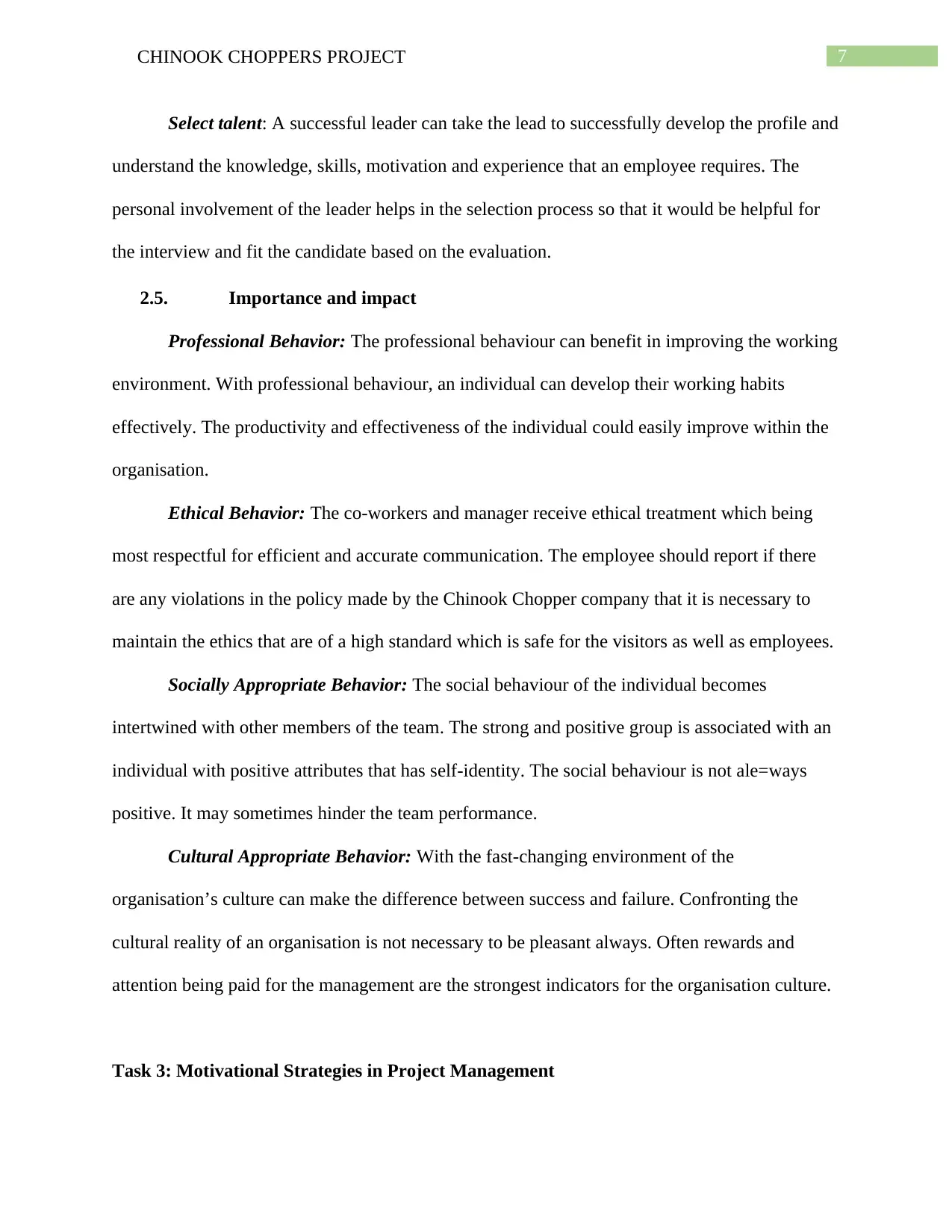
7CHINOOK CHOPPERS PROJECT
Select talent: A successful leader can take the lead to successfully develop the profile and
understand the knowledge, skills, motivation and experience that an employee requires. The
personal involvement of the leader helps in the selection process so that it would be helpful for
the interview and fit the candidate based on the evaluation.
2.5. Importance and impact
Professional Behavior: The professional behaviour can benefit in improving the working
environment. With professional behaviour, an individual can develop their working habits
effectively. The productivity and effectiveness of the individual could easily improve within the
organisation.
Ethical Behavior: The co-workers and manager receive ethical treatment which being
most respectful for efficient and accurate communication. The employee should report if there
are any violations in the policy made by the Chinook Chopper company that it is necessary to
maintain the ethics that are of a high standard which is safe for the visitors as well as employees.
Socially Appropriate Behavior: The social behaviour of the individual becomes
intertwined with other members of the team. The strong and positive group is associated with an
individual with positive attributes that has self-identity. The social behaviour is not ale=ways
positive. It may sometimes hinder the team performance.
Cultural Appropriate Behavior: With the fast-changing environment of the
organisation’s culture can make the difference between success and failure. Confronting the
cultural reality of an organisation is not necessary to be pleasant always. Often rewards and
attention being paid for the management are the strongest indicators for the organisation culture.
Task 3: Motivational Strategies in Project Management
Select talent: A successful leader can take the lead to successfully develop the profile and
understand the knowledge, skills, motivation and experience that an employee requires. The
personal involvement of the leader helps in the selection process so that it would be helpful for
the interview and fit the candidate based on the evaluation.
2.5. Importance and impact
Professional Behavior: The professional behaviour can benefit in improving the working
environment. With professional behaviour, an individual can develop their working habits
effectively. The productivity and effectiveness of the individual could easily improve within the
organisation.
Ethical Behavior: The co-workers and manager receive ethical treatment which being
most respectful for efficient and accurate communication. The employee should report if there
are any violations in the policy made by the Chinook Chopper company that it is necessary to
maintain the ethics that are of a high standard which is safe for the visitors as well as employees.
Socially Appropriate Behavior: The social behaviour of the individual becomes
intertwined with other members of the team. The strong and positive group is associated with an
individual with positive attributes that has self-identity. The social behaviour is not ale=ways
positive. It may sometimes hinder the team performance.
Cultural Appropriate Behavior: With the fast-changing environment of the
organisation’s culture can make the difference between success and failure. Confronting the
cultural reality of an organisation is not necessary to be pleasant always. Often rewards and
attention being paid for the management are the strongest indicators for the organisation culture.
Task 3: Motivational Strategies in Project Management
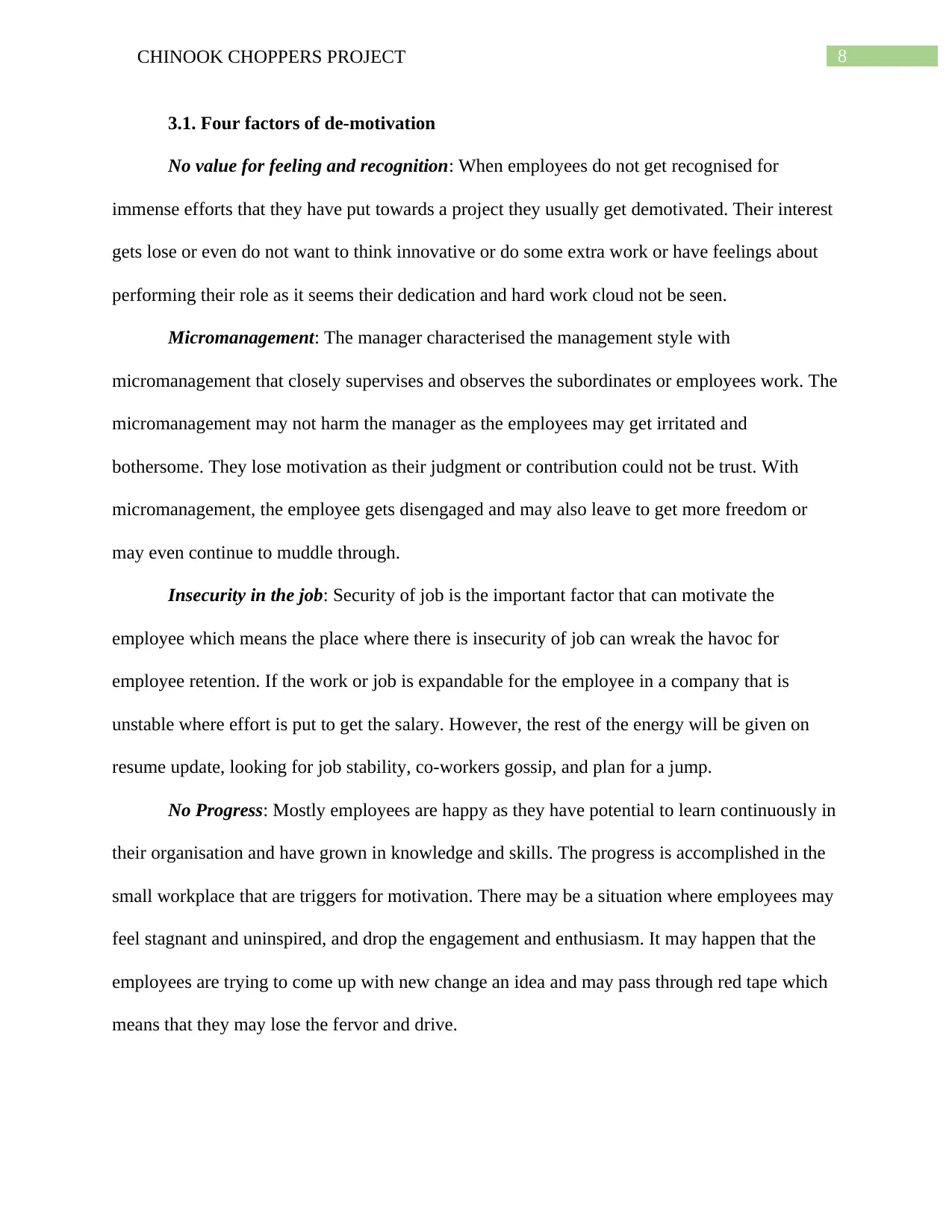
8CHINOOK CHOPPERS PROJECT
3.1. Four factors of de-motivation
No value for feeling and recognition: When employees do not get recognised for
immense efforts that they have put towards a project they usually get demotivated. Their interest
gets lose or even do not want to think innovative or do some extra work or have feelings about
performing their role as it seems their dedication and hard work cloud not be seen.
Micromanagement: The manager characterised the management style with
micromanagement that closely supervises and observes the subordinates or employees work. The
micromanagement may not harm the manager as the employees may get irritated and
bothersome. They lose motivation as their judgment or contribution could not be trust. With
micromanagement, the employee gets disengaged and may also leave to get more freedom or
may even continue to muddle through.
Insecurity in the job: Security of job is the important factor that can motivate the
employee which means the place where there is insecurity of job can wreak the havoc for
employee retention. If the work or job is expandable for the employee in a company that is
unstable where effort is put to get the salary. However, the rest of the energy will be given on
resume update, looking for job stability, co-workers gossip, and plan for a jump.
No Progress: Mostly employees are happy as they have potential to learn continuously in
their organisation and have grown in knowledge and skills. The progress is accomplished in the
small workplace that are triggers for motivation. There may be a situation where employees may
feel stagnant and uninspired, and drop the engagement and enthusiasm. It may happen that the
employees are trying to come up with new change an idea and may pass through red tape which
means that they may lose the fervor and drive.
3.1. Four factors of de-motivation
No value for feeling and recognition: When employees do not get recognised for
immense efforts that they have put towards a project they usually get demotivated. Their interest
gets lose or even do not want to think innovative or do some extra work or have feelings about
performing their role as it seems their dedication and hard work cloud not be seen.
Micromanagement: The manager characterised the management style with
micromanagement that closely supervises and observes the subordinates or employees work. The
micromanagement may not harm the manager as the employees may get irritated and
bothersome. They lose motivation as their judgment or contribution could not be trust. With
micromanagement, the employee gets disengaged and may also leave to get more freedom or
may even continue to muddle through.
Insecurity in the job: Security of job is the important factor that can motivate the
employee which means the place where there is insecurity of job can wreak the havoc for
employee retention. If the work or job is expandable for the employee in a company that is
unstable where effort is put to get the salary. However, the rest of the energy will be given on
resume update, looking for job stability, co-workers gossip, and plan for a jump.
No Progress: Mostly employees are happy as they have potential to learn continuously in
their organisation and have grown in knowledge and skills. The progress is accomplished in the
small workplace that are triggers for motivation. There may be a situation where employees may
feel stagnant and uninspired, and drop the engagement and enthusiasm. It may happen that the
employees are trying to come up with new change an idea and may pass through red tape which
means that they may lose the fervor and drive.
⊘ This is a preview!⊘
Do you want full access?
Subscribe today to unlock all pages.

Trusted by 1+ million students worldwide
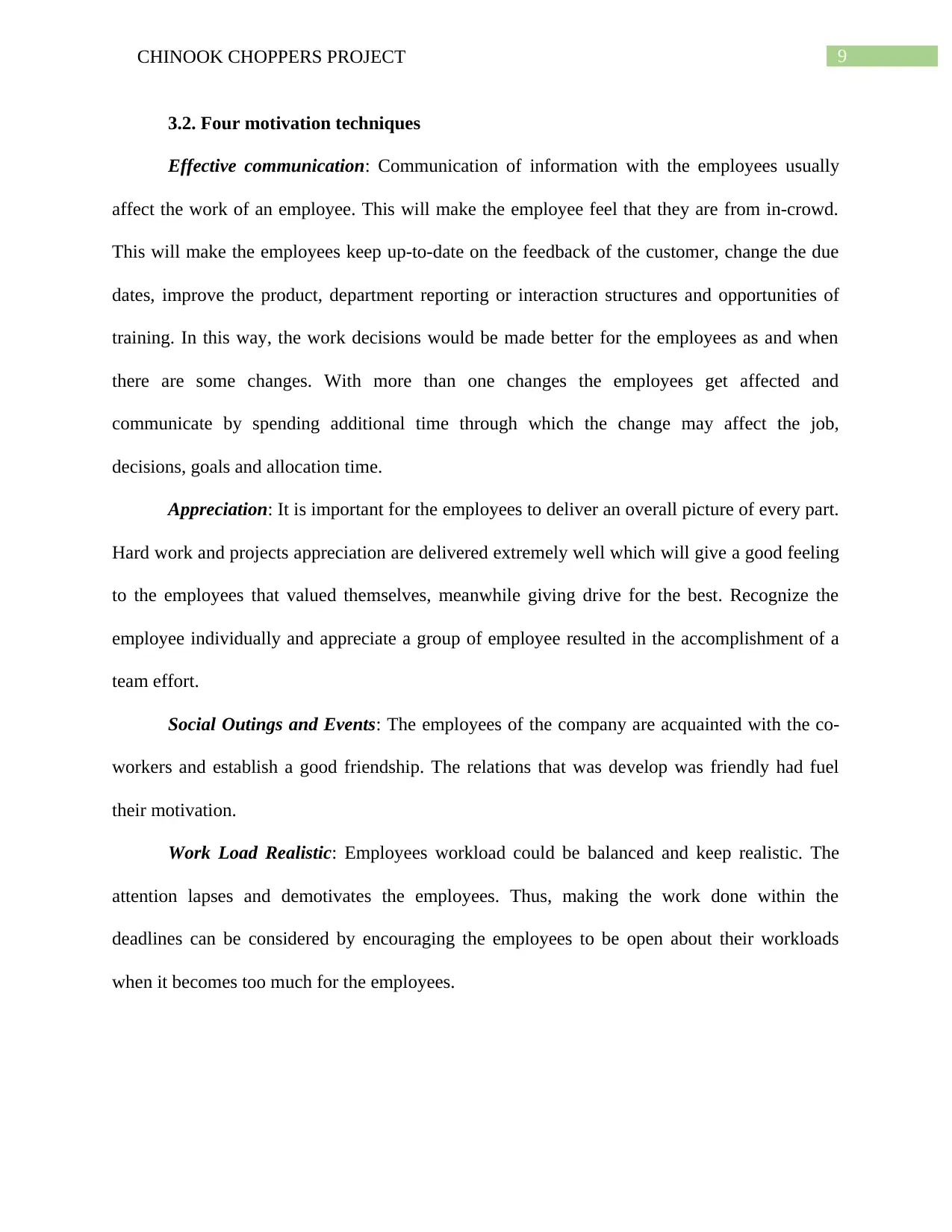
9CHINOOK CHOPPERS PROJECT
3.2. Four motivation techniques
Effective communication: Communication of information with the employees usually
affect the work of an employee. This will make the employee feel that they are from in-crowd.
This will make the employees keep up-to-date on the feedback of the customer, change the due
dates, improve the product, department reporting or interaction structures and opportunities of
training. In this way, the work decisions would be made better for the employees as and when
there are some changes. With more than one changes the employees get affected and
communicate by spending additional time through which the change may affect the job,
decisions, goals and allocation time.
Appreciation: It is important for the employees to deliver an overall picture of every part.
Hard work and projects appreciation are delivered extremely well which will give a good feeling
to the employees that valued themselves, meanwhile giving drive for the best. Recognize the
employee individually and appreciate a group of employee resulted in the accomplishment of a
team effort.
Social Outings and Events: The employees of the company are acquainted with the co-
workers and establish a good friendship. The relations that was develop was friendly had fuel
their motivation.
Work Load Realistic: Employees workload could be balanced and keep realistic. The
attention lapses and demotivates the employees. Thus, making the work done within the
deadlines can be considered by encouraging the employees to be open about their workloads
when it becomes too much for the employees.
3.2. Four motivation techniques
Effective communication: Communication of information with the employees usually
affect the work of an employee. This will make the employee feel that they are from in-crowd.
This will make the employees keep up-to-date on the feedback of the customer, change the due
dates, improve the product, department reporting or interaction structures and opportunities of
training. In this way, the work decisions would be made better for the employees as and when
there are some changes. With more than one changes the employees get affected and
communicate by spending additional time through which the change may affect the job,
decisions, goals and allocation time.
Appreciation: It is important for the employees to deliver an overall picture of every part.
Hard work and projects appreciation are delivered extremely well which will give a good feeling
to the employees that valued themselves, meanwhile giving drive for the best. Recognize the
employee individually and appreciate a group of employee resulted in the accomplishment of a
team effort.
Social Outings and Events: The employees of the company are acquainted with the co-
workers and establish a good friendship. The relations that was develop was friendly had fuel
their motivation.
Work Load Realistic: Employees workload could be balanced and keep realistic. The
attention lapses and demotivates the employees. Thus, making the work done within the
deadlines can be considered by encouraging the employees to be open about their workloads
when it becomes too much for the employees.
Paraphrase This Document
Need a fresh take? Get an instant paraphrase of this document with our AI Paraphraser
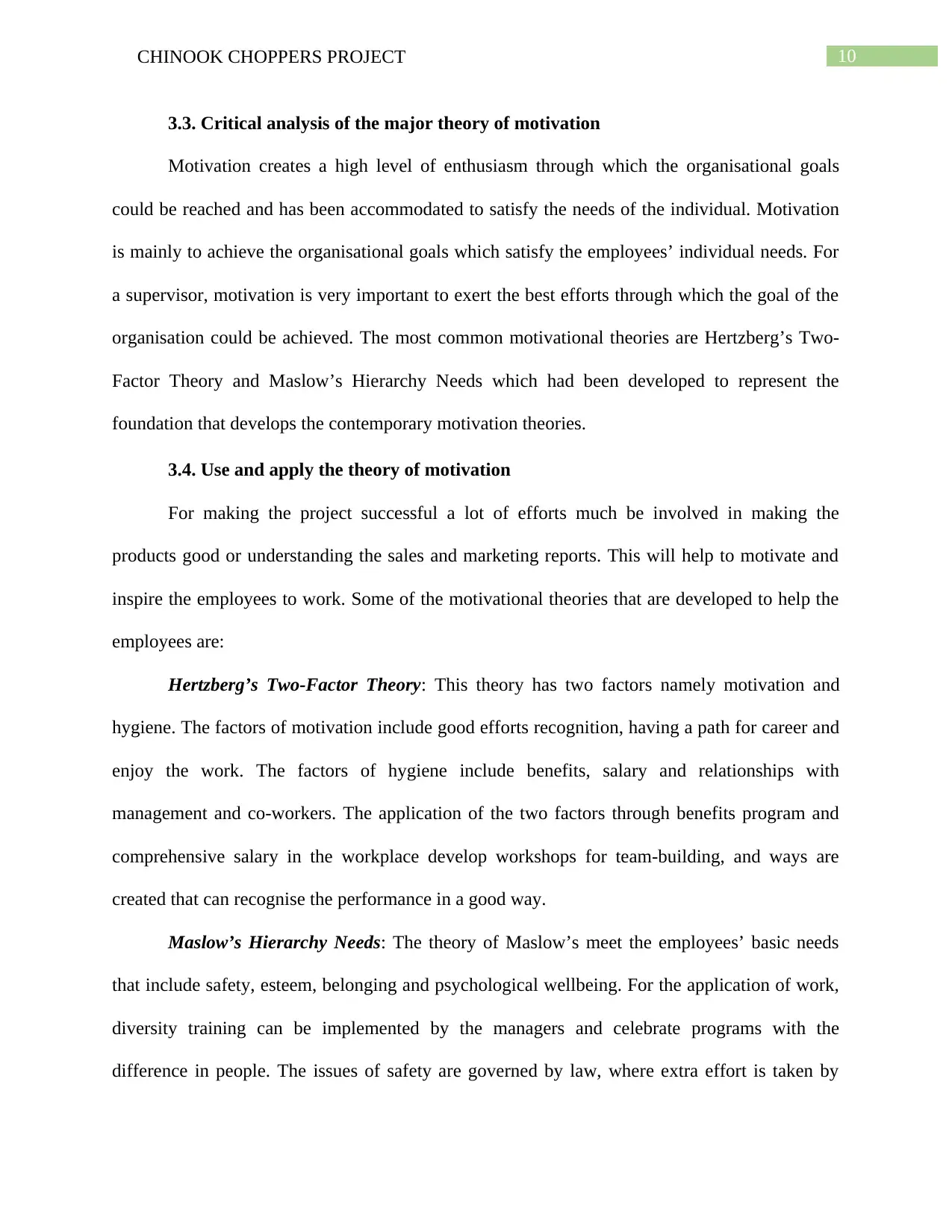
10CHINOOK CHOPPERS PROJECT
3.3. Critical analysis of the major theory of motivation
Motivation creates a high level of enthusiasm through which the organisational goals
could be reached and has been accommodated to satisfy the needs of the individual. Motivation
is mainly to achieve the organisational goals which satisfy the employees’ individual needs. For
a supervisor, motivation is very important to exert the best efforts through which the goal of the
organisation could be achieved. The most common motivational theories are Hertzberg’s Two-
Factor Theory and Maslow’s Hierarchy Needs which had been developed to represent the
foundation that develops the contemporary motivation theories.
3.4. Use and apply the theory of motivation
For making the project successful a lot of efforts much be involved in making the
products good or understanding the sales and marketing reports. This will help to motivate and
inspire the employees to work. Some of the motivational theories that are developed to help the
employees are:
Hertzberg’s Two-Factor Theory: This theory has two factors namely motivation and
hygiene. The factors of motivation include good efforts recognition, having a path for career and
enjoy the work. The factors of hygiene include benefits, salary and relationships with
management and co-workers. The application of the two factors through benefits program and
comprehensive salary in the workplace develop workshops for team-building, and ways are
created that can recognise the performance in a good way.
Maslow’s Hierarchy Needs: The theory of Maslow’s meet the employees’ basic needs
that include safety, esteem, belonging and psychological wellbeing. For the application of work,
diversity training can be implemented by the managers and celebrate programs with the
difference in people. The issues of safety are governed by law, where extra effort is taken by
3.3. Critical analysis of the major theory of motivation
Motivation creates a high level of enthusiasm through which the organisational goals
could be reached and has been accommodated to satisfy the needs of the individual. Motivation
is mainly to achieve the organisational goals which satisfy the employees’ individual needs. For
a supervisor, motivation is very important to exert the best efforts through which the goal of the
organisation could be achieved. The most common motivational theories are Hertzberg’s Two-
Factor Theory and Maslow’s Hierarchy Needs which had been developed to represent the
foundation that develops the contemporary motivation theories.
3.4. Use and apply the theory of motivation
For making the project successful a lot of efforts much be involved in making the
products good or understanding the sales and marketing reports. This will help to motivate and
inspire the employees to work. Some of the motivational theories that are developed to help the
employees are:
Hertzberg’s Two-Factor Theory: This theory has two factors namely motivation and
hygiene. The factors of motivation include good efforts recognition, having a path for career and
enjoy the work. The factors of hygiene include benefits, salary and relationships with
management and co-workers. The application of the two factors through benefits program and
comprehensive salary in the workplace develop workshops for team-building, and ways are
created that can recognise the performance in a good way.
Maslow’s Hierarchy Needs: The theory of Maslow’s meet the employees’ basic needs
that include safety, esteem, belonging and psychological wellbeing. For the application of work,
diversity training can be implemented by the managers and celebrate programs with the
difference in people. The issues of safety are governed by law, where extra effort is taken by
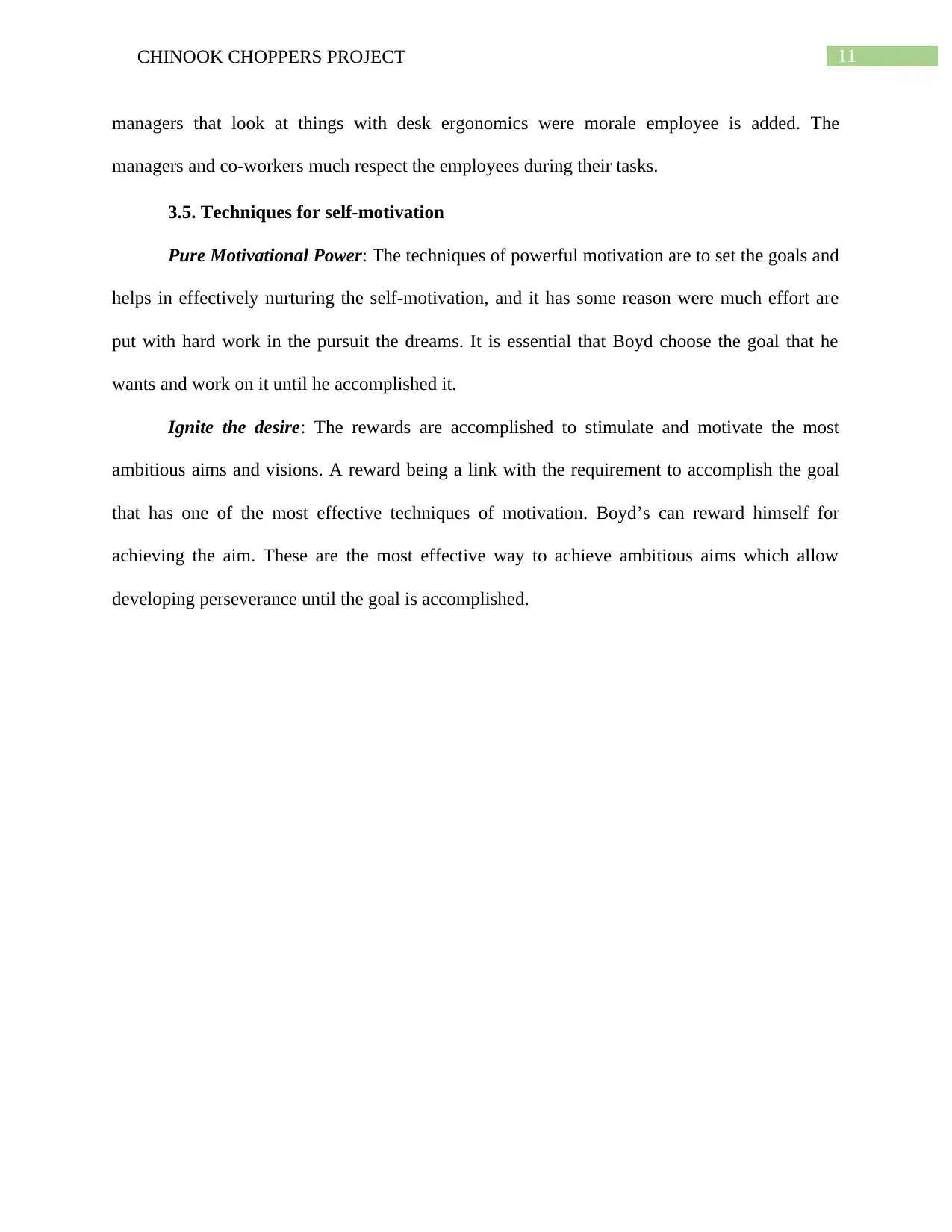
11CHINOOK CHOPPERS PROJECT
managers that look at things with desk ergonomics were morale employee is added. The
managers and co-workers much respect the employees during their tasks.
3.5. Techniques for self-motivation
Pure Motivational Power: The techniques of powerful motivation are to set the goals and
helps in effectively nurturing the self-motivation, and it has some reason were much effort are
put with hard work in the pursuit the dreams. It is essential that Boyd choose the goal that he
wants and work on it until he accomplished it.
Ignite the desire: The rewards are accomplished to stimulate and motivate the most
ambitious aims and visions. A reward being a link with the requirement to accomplish the goal
that has one of the most effective techniques of motivation. Boyd’s can reward himself for
achieving the aim. These are the most effective way to achieve ambitious aims which allow
developing perseverance until the goal is accomplished.
managers that look at things with desk ergonomics were morale employee is added. The
managers and co-workers much respect the employees during their tasks.
3.5. Techniques for self-motivation
Pure Motivational Power: The techniques of powerful motivation are to set the goals and
helps in effectively nurturing the self-motivation, and it has some reason were much effort are
put with hard work in the pursuit the dreams. It is essential that Boyd choose the goal that he
wants and work on it until he accomplished it.
Ignite the desire: The rewards are accomplished to stimulate and motivate the most
ambitious aims and visions. A reward being a link with the requirement to accomplish the goal
that has one of the most effective techniques of motivation. Boyd’s can reward himself for
achieving the aim. These are the most effective way to achieve ambitious aims which allow
developing perseverance until the goal is accomplished.
⊘ This is a preview!⊘
Do you want full access?
Subscribe today to unlock all pages.

Trusted by 1+ million students worldwide
1 out of 15
Related Documents
Your All-in-One AI-Powered Toolkit for Academic Success.
+13062052269
info@desklib.com
Available 24*7 on WhatsApp / Email
![[object Object]](/_next/static/media/star-bottom.7253800d.svg)
Unlock your academic potential
Copyright © 2020–2025 A2Z Services. All Rights Reserved. Developed and managed by ZUCOL.





